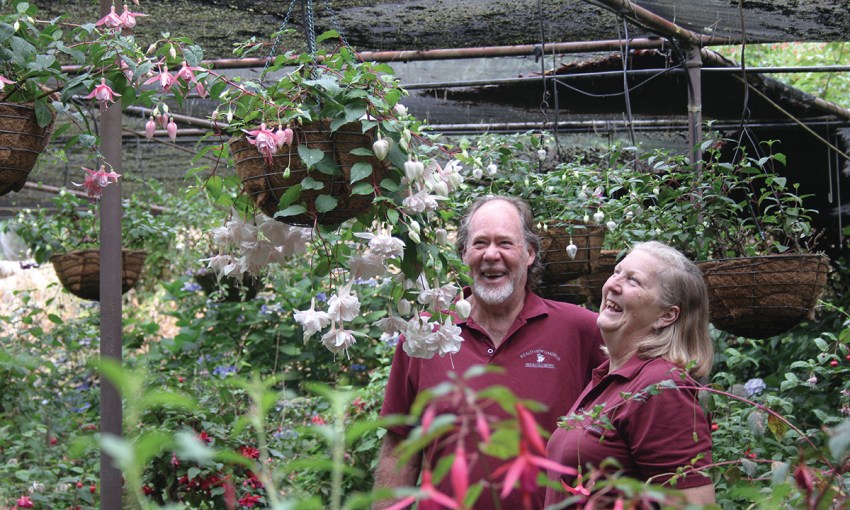Fuchsias may have fallen from fashion, but one Adelaide Hills family business has remained committed – and the results are spectacular.
A flamboyance of fuchsias
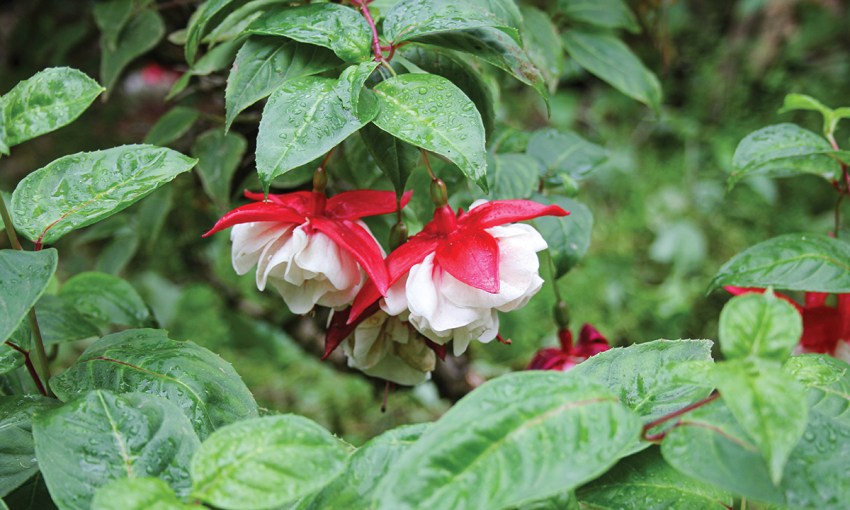
It’s hard to look at a fuchsia without being nostalgically transported back to granny’s garden where hanging baskets and every shaded undercroft were crowded with their delightfully nodding blooms. Like tiny ballerinas, feet dangling in mid-air, these elegant and perfectly formed flowers have been a curiosity and garden fascination for centuries, with the unopened buds a constant magnet for children to pinch and pop.
Sadly, fuchsias have experienced a slow decline in popularity over the past few decades. In part due to drought and severe water restrictions and partly to the steadily increasing number of other “in vogue” plant varieties available to the home gardener.
However, given the move towards medium and higher density living reducing the footprint of gardening space to a small courtyard or balcony, where part sun and shade are more commonplace, the demand for hardy, long-flowering plants capable of thriving in these conditions is at an all-time high. So, it’s definitely time to reacquaint ourselves with the ever-reliable and abundantly-blooming fuchsia.
Thankfully, one family has kept the fuchsia faith over the years. Roger and Chris Scrase have been growing and selling fuchsias from their Weald View Gardens nursery at Ashton since 1983. While Roger’s family comes from a long line of Adelaide Hills market gardeners, dating way back to the 1870s, the move from picking Brussels sprouts to propagating fuchsias was conceived by Roger’s late father, Don. An avid gardener and accomplished musician, Don’s dalliance with fuchsias, as a distraction in retirement, quickly grew to an obsession and a new and more profitable direction for the family farm.
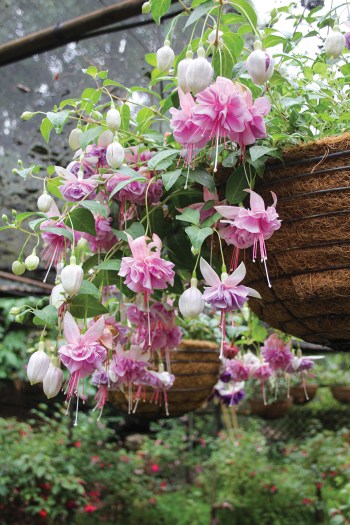
Named after the ancestral family home “Weald View” (a weald being an undulating area) in Sussex, UK, Weald View Gardens is aptly named, nestled contentedly in the rolling and picturesque Hills.
The jewel in the Weald View Gardens crown is its showstopping display garden, opposite the Ashton Post Office Cafe. Open to the public on weekends and public holidays, step through the entrance, free of charge, and be prepared for a floral feast. The 1500 square metres of taught shadecloth is home and a haven to more than 500 fuchsias, planted in an array of suspended baskets and raised garden beds, filling and colouring the space. Informal, intertwining paths, edged with rocks picked and piled from the farm’s clearing in the 1890s, beckon visitors to follow and meander amongst these astounding and spectacular plants.
Apart from the sheer volume of flowers, Weald View Gardens display is a presentation of the fuchsia like nowhere else in this state. Here you can take your time to explore and admire the multiple hues and styles this glorious genus has to offer.
A native of the Dominican Republic’s idyllic and diverse topography, fuchsias were discovered there and introduced to Europe by missionary and botanist Father Charles Plumier in the late 17th century. Named after German botanist Leonard Fuchs, busy hybridisers quickly expanded the types and colours well beyond the original reddish-orange Fuchsia triphylla. Spontaneous mutations amongst existing plants provided breeders rare opportunities to add new colours, flower styles and growth habits to the palette including whites, double blooms, marbling and the exciting colour combinations exhibited in today’s modern cultivars. Wander Weald View Gardens display and you quickly appreciate the diversity of this species.
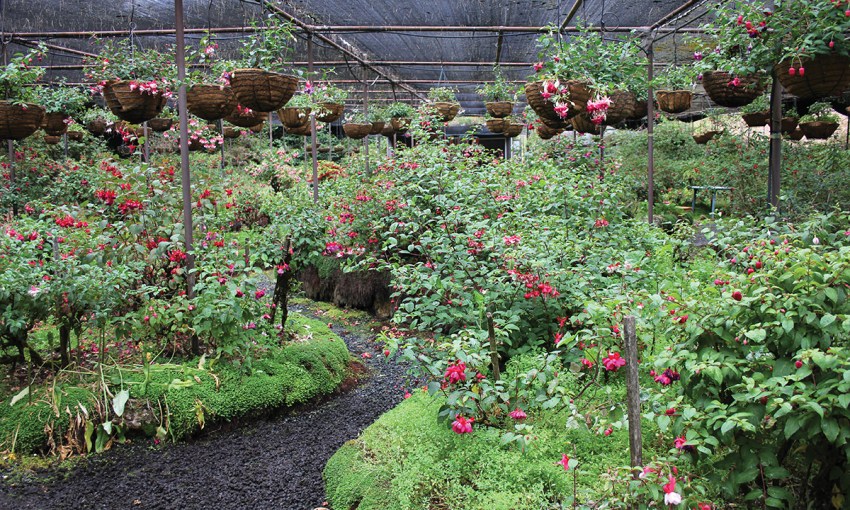
Fuchsias also grow readily from seed. Weald View Gardens allow flowers to age on the bushes assisting bees and birds hungry for nectar to flit from one flower to another, brushing past the prominent stamens and inadvertently picking up tiny specs of pollen before sharing them with other blooms along their feeding journey. As seeds develop and mature, they drop to the rich earth below and germinate. This natural cross-fertilisation produces seedlings with a random mix of attributes. Like proud parents, Roger and Chris Scrase carefully lift each delicate seedling and lovingly give it its own pot.
These “chance” seedlings are extensively trailed and assessed over many seasons with particular attention to health and hardiness, along with flower stability, colour and overall appeal. While the path to commercial sale is brutal – and the vast majority fail the test – there are a number of outstanding varieties that pass with flying colours.
Releasing a new variety also provides the opportunity to name and, in some cases, bestow the honour on someone special. “Don Charles”, named after Roger’s late father, is a standout variety with its double bloom mix of regal purple blooms and classic fuchsia pink sepals produced continuously through the flowering season. Lax growing, this is equally suited to hanging baskets or a well-drained garden bed.
Weald View Gardens have released a large number of seedling varieties including “Weald View Garnet”, a spreading grower with small purple and pink blooms, along with another named “Christine Mary” after co-owner Chris Scrase.
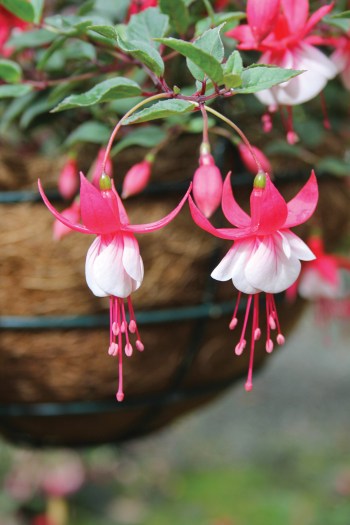
When it comes to choosing fuchsias, the most important consideration is location. Frost is the mortal enemy of many fuchsias, so frost-free or protected growing areas are essential.
Most fuchsias perform their best in filtered light or morning sun with afternoon shade. Sun-loving varieties such as “Loxhore Herald”, planted by the Weald View Garden display entrance, grows upwards of a metre and a half tall and is tolerant of reduced watering once established, making it an ideal hedging option in hills and temperate areas.
Fuchsias are classified into three main growth habits: upright, basket and lax. Upright types such as “Mary Neajean” and “Walz Jubelteen” are typical garden fuchsia producing a framework of branches that support the foliage and flowers. Growing from half a metre to upwards of two metres, upright growers perform in both well-drained soil and pot alike.
Basket varieties such as the stunning white “Santa Clara”, have been bred to fill and billow over a hanging basket. Evenness of growth and constancy of flower have maintained the popularity of basket varieties. Hung under a pergola or suspended on a balcony, they create plenty of options to vertically extend a shrinking garden space.
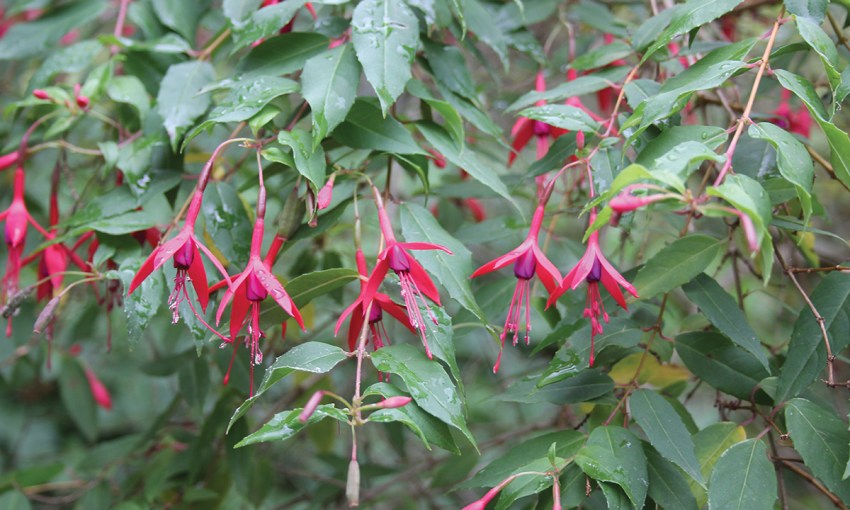
Lax fuchsias produce long arching canes. The Australian bred “Snow Burner” has been described as one of the world’s best red and white varieties and an excellent example of a lax grower. As with basket varieties, lax growers are also suited to hanging baskets and pots with planting in well-drained ground preferred for long term growth.
Drainage is critical for fuchsia success. Well-drained garden soil will ensure strong root development without the issue of rot. Hanging baskets and pots drain naturally and a premium potting mix provides the essentials for a great start. Hanging baskets tend to dry out so shielding from direct wind, especially those hot northerlies, and adding mulch will keep these fuchsias happy and flowering a treat.
When it comes to pot size, the bigger the better. As fuchsias grow quickly, replacing plants every four years prevents them from developing that woody, bonsaied look.
Plant, pot or hang, there are so many ways for fuchsias to add a splash of joyful colour to your autumn and winter garden, no matter its size. Drop by Weald View Gardens or your local garden centre to discover – or maybe rediscover – the wonderful world of fuchsias.
This story first appeared in the March 2021 issue of SALIFE magazine.



